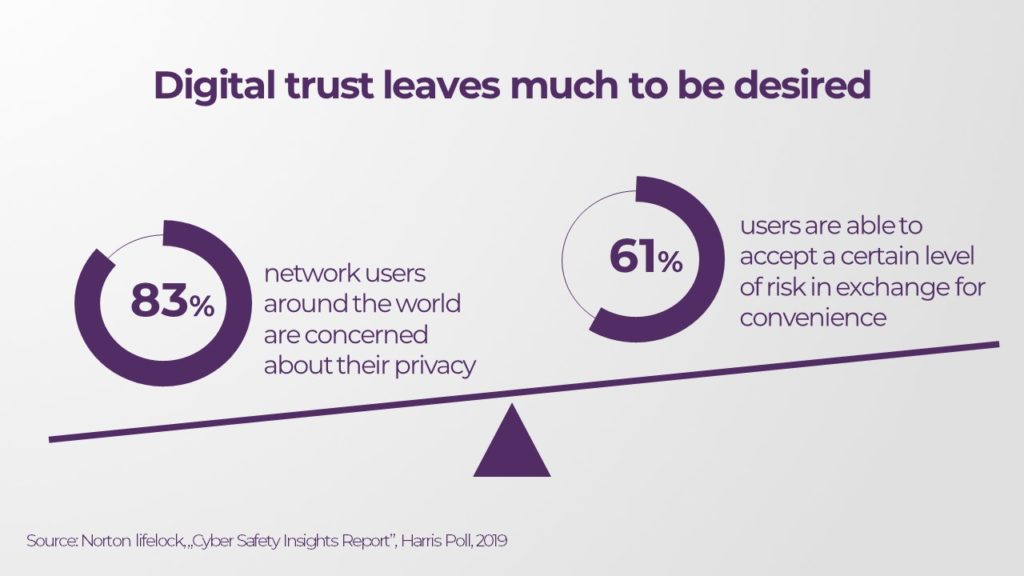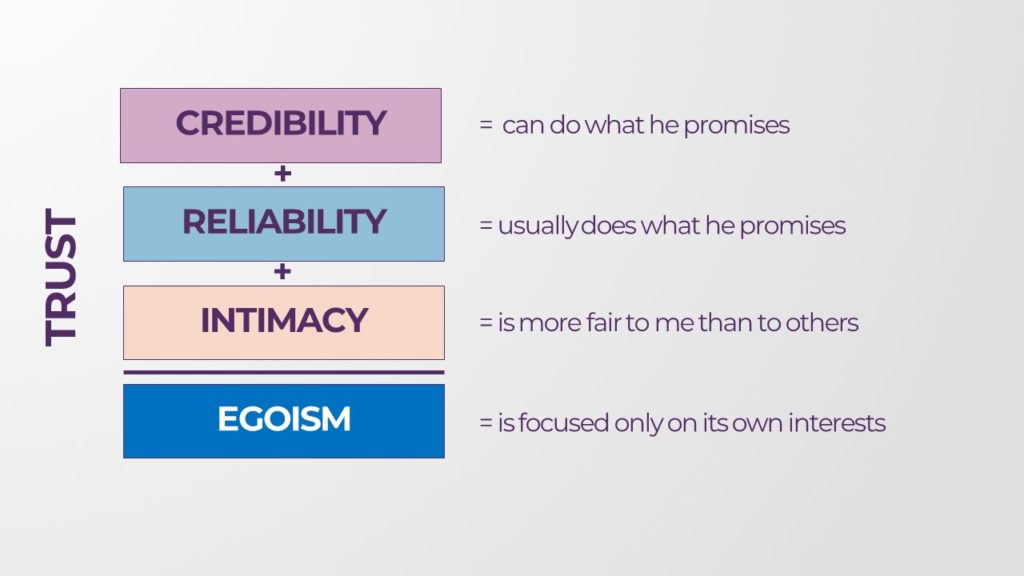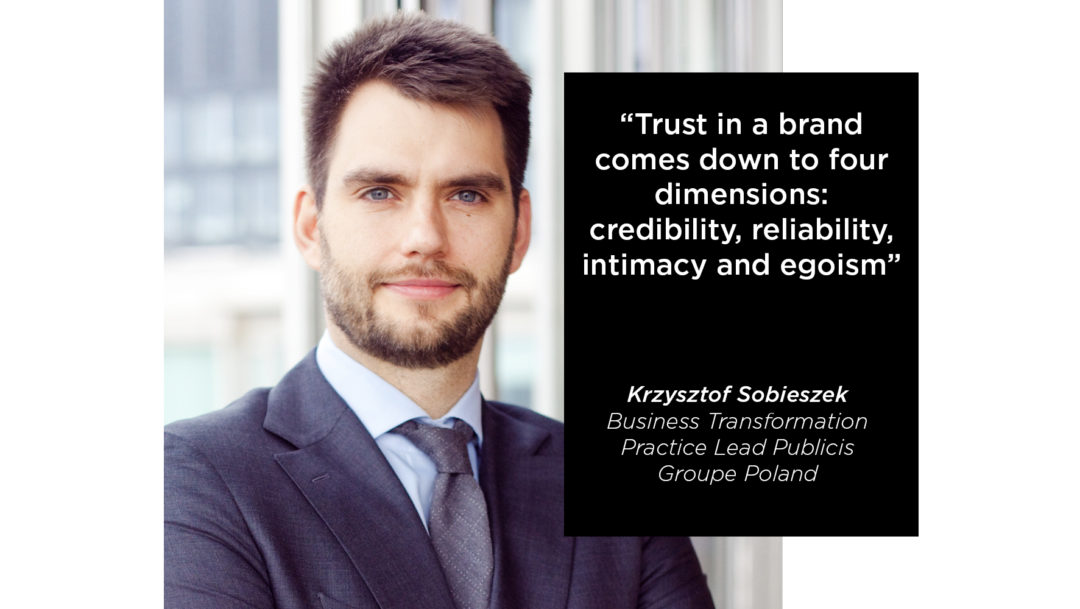CMO Insider contains a lot of content on the role of CMOs in the digital transformation of the company. We try to address the most important topics that marketing directors should pay attention to in order to become leaders in the transformation of their companies. Undoubtedly one of them is the issue of consumer confidence in the digital age.
In this context it is worth answering two questions:
- How to consider consumer confidence in a brand in the digital environment?
- Is the very concept of trust in an extremely dynamic digital environment being transformed? How do we look at trust today?
The toxic terms “transformation” and “trust”
The digital transformation has changed in recent years and is being discussed in almost every context in which companies operate. This is not without reason. The dynamically growing transformation efforts of companies have been additionally accelerated in many cases by the pandemic crisis. However, this has an interesting side effect – most likely if we meet two people talking about digital transformation they will have a different definition and key elements in their heads.
For this reason, although it is an important and, in fact, crucial concept for modern business, it is at the same time toxic to some extent. Each time we have to define which aspects of the transformation we are referring to. The same goes for trust. This is a term used in a very broad context and completely different aspects of the term are discussed interchangeably. So in order to talk about building trust in a useful way, it is worth looking at this in more detail.
Digital Trust
The issue of consumer confidence in a dynamic digital environment remains one of the most topical raised business issues. In general, this is directly related to the transparency of data collection, processing and use by different players in the digital market: social networks, content publishers, retailers, brands, agencies, technology providers and many others. The huge potential for personalized data collection, the complexity of the value chain, high cost-effectiveness and very modest regulation were supposed to lead to bad experiences of network users, non-transparent data practices and, consequently, a drop in trust and phenomena such as the increasing scale of adblock software installation. A lot of data that appears on the market does not allow us to disagree with this statement. For example, according to the Norton Lifelock study, “Cyber Safety Insights Report” conducted by Harris Poll, in 2019 as many as 83% of network users worldwide fear for their privacy. You “get” all market participants, but important hotspots remain, for example, personalized digital marketing or digital products and services that make advanced use of consumer knowledge. These areas are, of course, crucial for today’s CMOs.
There is one fundamental challenge to digital confidence in this sense. It is a form of social trust for which all market players are responsible, but none of the players has enough power to significantly influence trust. Many experiments in social sciences have shown that building social trust has an interesting dynamic. In a nutshell: it is extremely easy to break it down (the behavior of individual players is enough, e.g. the Cambridge Analytica scandal involving Facebook), and very hard to build (the actions of even many players at once do not build it in a sufficient manner). In this context market regulations such as GDPR are the right way to go, however, even they are not enough if people will be confronted with information about data leaks or even single cases of personalization abuse.
Is digital marketing therefore doomed to mistrust?
Firstly, the picture is not clearly black. In the aforementioned Norton Lifelock study, as many as 61% of the people interviewed are able to accept a certain level of risk on the web in exchange for convenience. This means that good and useful experiences, to some extent offset the lack of digital trust, the brands of which are often victims of collective responsibility (even if their data processes are correct and ethical).
Secondly, general digital trust is only the first element. The second is trust in specific brands, of which the potential of a marketing director is much greater.

Mutual trust in the digital market
In addition to the general digital consumer confidence in the market as described above, which can be summarized as “I trust that the network as an ecosystem works, is secure and takes various actions in it and will give a similar result every time”, marketers in the process of transformation build solid confidence in our company and brand. What does it really mean to be trustworthy? There are many concepts, but this basically comes down to 4 dimensions:
1. Credibility – does a brand know (has the competence) to deliver what it promises?
2. Reliability – does it usually deliver what it promises?
3. Intimacy – a belief in the special trust between me and the brand (unique, different from others).
4. Egoism – the belief that a brand takes action solely for its own benefit.
The dimensions defined in this way are actually an equation where credibility, reliability and intimacy are in the numerator (the greater they are, the greater is trust), while egoism in the denominator (egoism reduces trust).
So you can look at what changes in building consumer confidence. The order of their discussion is not coincidental. It reflects how I perceive importance.

Reliability
Reliability seems to be a fundamental and still growing dimension in importance. In the context of digitization, it simply means that the experience provided by the brand is repetitive. In other words: “it always works”. This obviousness is not at all easy to execute, given the number of digital points of contact with the consumer and the increasing complexity of the technologies behind the experience. Each of us can quite easily recall the brands with which we experience technology problems exceptionally often. The accidental disappearance of a filled shopping cart in an online store, an advertisement containing an interesting offer which is not clickable, interesting brand content cut in half, a problem with correct payment processing. The correct operation (in a literal sense) of the solutions we provide the client with will be of key importance. If the VOD service to which we have purchased access did not work just on a Saturday evening when we sat on the couch with hot popcorn, it will raise significant doubts in us whether next Saturday we can count on it to provide us with the desired entertainment. It is this repetitiveness that builds brands that consumers trust most in the digital environment.
Egoism
Egoism is a very interesting dimension. Reducing the dimension of brand egoism is not only convincing the consumer that the company is not focused on its own interest. In contrast, it is also about showing a real focus on consumers.
One of the more helpful tools here is useful personalization. Showing the customer that the information collected by us is used to really improve their comfort can be seen as proof of greater symmetry in the relationship (make sure I’m comfortable).
At the same time it is a difficult area. The truth is that the data and the resulting active personalization are still most often used for purely business purposes such as customer acquisition, loyalty, increasing the value of the basket, etc. Of course, such an approach is fully justified in business terms. However, the dimension of selfishness and trust is influenced by the use of personalization mainly to improve customer experience. The second element often used by brands associated with this dimension of trust is a broad understanding of social engagement.
This is, in a sense, directly shows consumers social altruism. Regardless of the fact that such brand behavior is worthy of approval, its effectiveness is still questionable. Accusations of insincerity and so-called greenwashing are growing around many such actions, and their implementation requires a great communicative sense. A good example is the loudly discussed campaign of the luxury fashion store Molière2, which promised to donate PLN 2 to the Foundation To Save Children with Cancer for every picture with high heels published in social media with the hashtag #DzieńSzpilek. An additional context for the action was the earlier communication of the brand with quite controversial overtones, perceived by many as chauvinistic. Despite many positive reactions, the brand also experienced a large wave of outrage and criticism against the campaign.
The most promising form of influencing the dimension of brand egoism in building trust is related to the essence of transformation, i.e. building new digital services and products.
We can build entire mechanisms to minimize brand egoism into them. A great example is one of the hottest startups in Silicon Valley – Lemonade, which debuted on the stock exchange this year with great success. Lemonade has made a very interesting transformation of the traditional model in the insurance industry based on the zero-sum game between two “players” with opposing goals. The financial success of an insurer depends largely on… minimizing claims paid. On the other hand, the insured often take an antagonistic attitude towards companies by overstating claims. Lemonade has introduced a third player to his model – charities. The company charges a fixed commission and transfers the surplus in the system (pool) to the social goals indicated by the insured. Thus, it is “excluded” from the scheme of egoism. Overstatement of claims hits… charities and Lemonade’s clients knowing this, are much less likely to make such attempts.
Credibility
In building brand credibility they have always had one of the basic tools – creating quality content in their area. Digital media have not created this mechanism, but have significantly increased its scale. Not every brand has to focus on building credibility through content. Content, in turn, is not just about building credibility. However, it is undoubtedly a tool currently used on a much larger scale. A new native member called Guzik came into my home some time ago. Guzik is a schnauzer, and I get most of the information about his upbringing, nutrition and care from the digital channels of the Johndog.pl online store. The quality and adequacy of the content distributed by the company has effectively built a sense of credibility in me and I trust the brand enough not to look for much information in other sources.
Intimacy
Intimacy in digital media is a problem area. The network tries to provide us with tools to build an impression of intimacy but is still not an optimal environment for this purpose. The truth is that we are still at the stage of a fairly common problem of constructing a simple conversation bot, which does not irritate consumers in a simple, purposeful conversation. All the more often it is to build a sense of a unique bond and a sense of ‘special circle of trust’ with individual consumers. Even if we manage to achieve a goal through a digital channel, for example, empathic customer service staff will be more effective than automated experiences and processes. Interestingly, it is precisely with the dimension of intimacy in mutual trust that the processing of particularly sensitive consumer data is quite often identified. In other words, by building better and more transparent data processes, we are supposed to convince consumers that it is worth entrusting this data to our company. In my opinion, this is not a fully considered approach.
As I have written above, the willingness of consumers to share their data will depend mainly on the overall digital trust, not on the actions of individual brands. It is hard for me to imagine that a better personal data processing policy would be a real factor building a competitive advantage and influencing consumer choices.
The truth is, however, that proper, ethical and secure data processing procedures are needed by brands, and while it is difficult to stand out positively in this way, there is a considerable risk of a strong negative effect in the event of a noticeable and loud failure. This will probably affect both our brand and the entire market and this is worth avoiding it at all costs.
Transformation of Trust
Is it worth summarizing whether there are any permanent changes in the approach to trust from such an image?
Firstly, in my opinion, the quite common thesis that trust is in crisis is not entirely correct. Trust in the new digital context is simply different, it is subject to change.
It is no longer a base or necessary basis for every transaction. In a digital environment, trust is rather a variable in the game to get results. Consumers invest their money, time, emotions, etc. to achieve some effect. Trust is important to them, but it is not a fundamental factor. If this were the case with quite a dramatic level of trust, the network would not develop as dynamically.
In this context trust loses its soft nature. It becomes a parameter that each brand can define itself and then include in the pool of analyzed indicators and models.
Finally, such a definition better prepares us for a situation in which trust is no longer typically human in nature. In the world of automated digital marketing algorithms must also learn to trust and inspire trust.
The article is based on the IAB 2020 Forum presentation “Trust in Transformation, the Transformation of Trust”.

